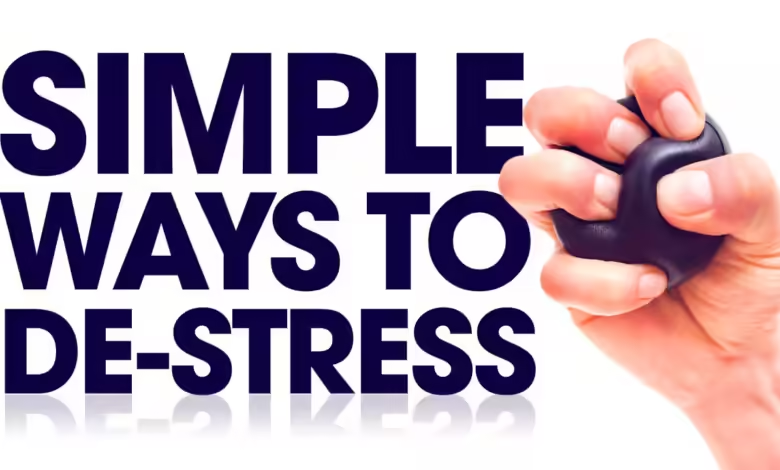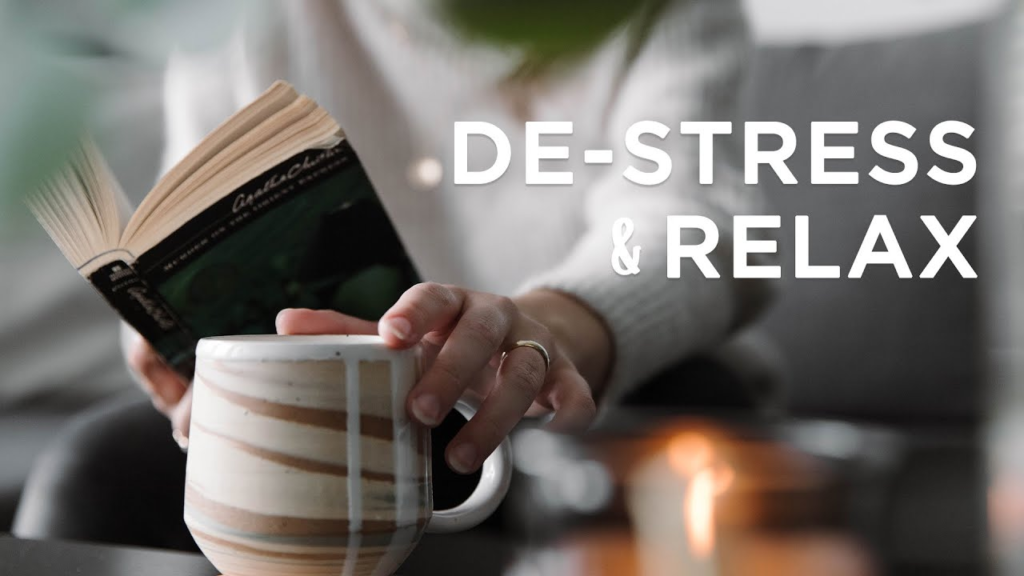relax and de-stress: 2024 great tips

RELAX AND DE-STRESS The situations and pressures of everyday life can take a significant toll on our overall health and well-being. From experiencing persistent feelings of depression, irritability, and anxiety to physical ailments like nausea, dizziness, and chest pain, stress can present itself in a myriad of debilitating ways.

Relax and de-stress, These symptoms not only impact our emotional state but can also lead to serious physiological consequences if left unchecked. Finding the time and cultivating effective ways to relax and unwind is essential for reducing the negative effects of stress on both our bodies and minds. By relieving built-up tension and calming our raging emotions, relax and de-stress, the practice of relaxation can provide much-needed respite and restoration.
There’s arguably no better time to start or recommit to a relaxation practice than on National Relaxation Day. Observed annually on August 15th, this unofficial holiday offers a timely reminder of the importance of rest and recovery for our overall health and quality of life. By promoting awareness about the substantial benefits of relaxation, this day encourages individuals to explore new techniques and incorporate them into their daily routines. RELAX AND DE-STRESS
This National Relaxation Day, it’s the perfect opportunity to recover from the debilitating effects of stress and refresh both your mind and body. By trying out a variety of relaxation methods, you can discover which ones resonate most and work best for your unique needs and preferences. Here are 10 proven techniques that can facilitate deeper relaxation and enhanced well-being:
One of the simplest yet most effective ways to unwind and relax is to venture outside and immerse yourself in the healing power of nature. Spending quality time outdoors has been shown to offer a wealth of physical and emotional health benefits. The act of connecting with the natural world can make you feel instantly calmer, more centered, and deeply relaxed.
Table of Contents
Whether it’s taking a leisurely stroll through a local park, hiking a scenic trail, or simply sitting and observing the beauty around you, spending more time outdoors can serve as a powerful antidote to the stresses of everyday life. The fresh air, natural sunlight, and inherent peacefulness of nature have a profoundly restorative effect that can help you recharge your batteries and return to your daily responsibilities feeling refreshed and rejuvenated.

Here is the passage elaborated and made longer: SPEND TIME IN NATURE While spending time in nature may not directly check things off your to-do list, it can provide immense benefits for stress relief. Being surrounded by the natural world has a profound calming effect on the mind and body. The sights, sounds, and smells of nature work to reduce your stress response, so when you return to the demands of work, you’ll feel much less overwhelmed.
relax and de-stress, If you don’t have the time or ability to get outside for extended periods each day, you can still bring the restorative power of nature to your work environment. Consider placing a small plant or tabletop water fountain on your desk. Studies show that simply having a touch of natural beauty nearby can lower stress hormone levels and boost feelings of tranquility. Even a few minutes of gazing at a calming natural scene can hit the reset button on your mind.
Relax and de-stress, One of the key reasons mindfulness meditation has become so popular in recent years is its remarkable ability to induce a state of deep relaxation. During a mindfulness session, the primary goal is to remain fully present and attentive to the current moment, without judgment or attachment. This heightened awareness allows you to tune into the sensations in your body with clarity.
Pay close attention to areas of muscular tension, such as your shoulders, neck, or lower back. As you breathe deeply, consciously relax and release the tightness in those trouble spots. The more you practice this mind-body connection, the more quickly you’ll be able to achieve a profoundly calm and serene state. Over time, a consistent meditation routine may even help you gradually improve your overall stress levels.
Stress and poor posture can lead to painful muscle tension, which only exacerbates feelings of anxiety and being overwhelmed. Heat therapy provides a natural, holistic solution to address this common problem. When applied to sore, tight muscles, the warmth from a compress or heating pad penetrates deep down into the tissue.
relax and de-stress, This warmth triggers the dilation of blood vessels, promoting increased blood flow and oxygen circulation. As the muscles begin to relax, the built-up tension is released, providing relief from aches and pains. Many find that heat therapy induces a sense of calm and well-being, as the body’s stress response is minimized. For maximum benefits, try pairing heat therapy with gentle stretching or massage to further melt away muscular tightness.
relax and de-stress, Incorporating this simple self-care practice into your routine can go a long way in managing stress. Original Passage: at least 15 minutes and up to 2 hours for the deepest sense of relaxation. It’s important not to use a heat source that’s so hot it burns your skin. Heat therapy is a relaxation tool you can safely use on a daily or weekly basis to help you unwind. Elaborated Passage: Engaging in heat therapy can be an incredibly beneficial practice for achieving a deep state of relaxation and unwinding.
relax and de-stress, Whether it’s a warm bath, a sauna session, or the use of a heating pad or hot pack, exposing your body to gentle, soothing heat can have a profound effect on your physical and mental well-being. The recommended duration for heat therapy can vary, but experts suggest starting with at least 15 minutes and gradually increasing the time up to 2 hours for the most profound sense of relaxation.
This extended duration allows your body to fully respond to the heat, promoting blood circulation, reducing muscle tension, and triggering the release of endorphins – the body’s natural feel-good chemicals. It’s crucial, however, to ensure that the heat source you use is not so hot that it burns or damages your skin. relax and de-stress, Moderation is key, as excessive heat can be counterproductive and even harmful. The ideal temperature should be warm and comforting, but not uncomfortably hot.

Incorporating heat therapy into your self-care routine, whether daily or weekly, can be a highly effective way to help you unwind, relax and de-stress, reduce stress, and achieve a deeper state of relaxation. By taking the time to immerse yourself in the soothing warmth, you can allow your body and mind to recharge, leaving you feeling refreshed, rejuvenated, and better equipped to tackle the demands of daily life.
Exercise is a powerful tool for both invigorating and soothing the body and mind. Though it may seem counterintuitive, the physical exertion of exercise can actually have a calming and restorative effect. After engaging in physical activity, your body experiences a reduction in the stress hormones adrenaline and cortisol. This hormonal shift helps to counteract the effects of chronic stress, which can take a significant toll on both physical and mental well-being.
RELAX AND DE-SRESS, Simultaneously, exercise triggers the release of endorphins – the body’s natural “feel-good” chemicals. Endorphins elevate your mood, induce a sense of calm, and even reduce pain perception. Beyond the physiological benefits, exercise also provides an important psychological respite from the demands and pressures of daily life.
By redirecting your focus to the present moment and the sensations of your moving body, exercise allows you to temporarily step away from whatever is causing you stress or anxiety. This mental break can have a profoundly restorative effect, relax and de-stress, helping you return to your tasks and responsibilities with renewed energy and clarity.
Furthermore, the embodied self-awareness cultivated through physical activity can enhance your understanding of your own needs and limitations. As you learn to attune to the subtle signals of your body, you’ll become better equipped to identify areas of tension or imbalance that require attention and relaxation. This self-knowledge, in turn, relax and de-stress, can inform your approach to stress management and self-care.
One particularly effective way to leverage the stress-relieving benefits of exercise is through the practice of yoga. Yoga combines physical movement, breath control, and mindfulness meditation into a holistic practice that targets both the body and the mind. The physical postures and sequences of yoga work to release muscular tension and improve flexibility, while the deep, rhythmic breathing calms the nervous system and induces a state of relaxation. RELAX AND DE-STRESS
Simultaneously, the emphasis on present-moment awareness and mental focus helps to quiet the incessant chatter of the mind, allowing you to let go of anxious thoughts and ruminations. Yoga is also a highly accessible and versatile practice. You can develop a simple yoga routine in as little as 10 minutes per day, fitting it seamlessly into your schedule. relax and de-stress, Whether you choose to start your day with a centering yoga session, take a mid-afternoon break to rebalance your nervous system, or wind down before bed, yoga offers a pathway to physical, mental, and emotional restoration.
RELAX AND DE-STRESS, Through the integration of movement, breath, and mindfulness, the practice of yoga provides a powerful antidote to the stresses of modern life. By investing even a small amount of time in this transformative practice, you can tap into the body’s innate capacity for self-regulation and rediscover a profound sense of calm, clarity, and well-being.






